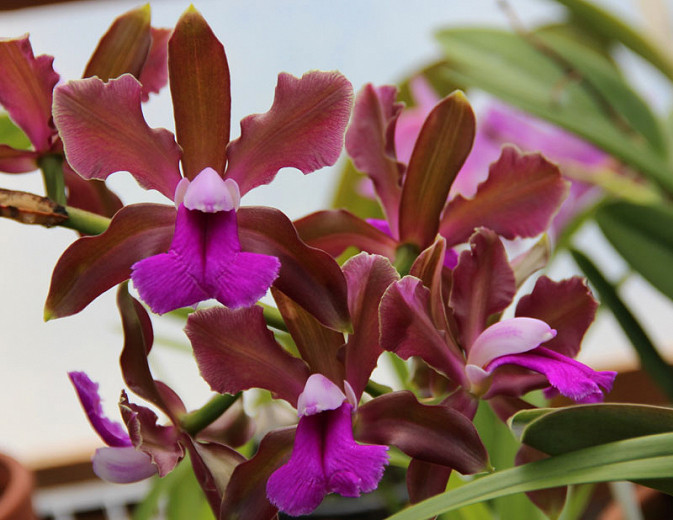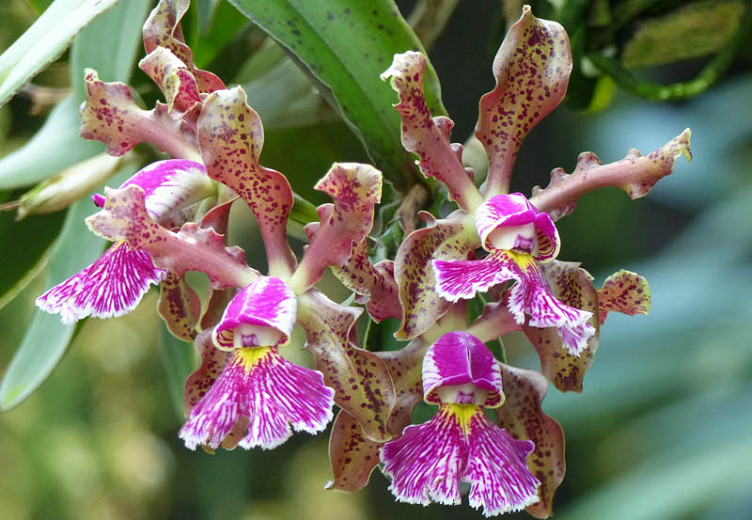Cattleya bicolor (Corsage Orchid)
Cattleya bicolor (Corsage Orchid) is an epiphytic orchid boasting 2-5 inflorescences giving rise to highly fragrant, long-lived flowers. Blooming in the spring and early summer, occasionally in the fall, the scented blossoms, 4 in. across (10 cm), feature green sepals and petals flushed with bronze and a rich crimson-purple lip.
Cattleya bicolor (Corsage Orchid) is an epiphytic orchid boasting 2-5 inflorescences giving rise to highly fragrant, long-lived flowers. Blooming in the spring and early summer, occasionally in the fall, the scented blossoms, 4 in. across (10 cm), feature green sepals and petals flushed with bronze and a rich crimson-purple lip. The slender cylindrical pseudobulbs carry 2 stiff, leathery green leaves, about 7 in. long (18 cm). Native to Brazil, Cattleya bicolor is a cool to warm growing orchid species found in forests in coastal mountains at elevations of 3280-4600 ft. (1000-1400 m).
- Grows up to 20-30 in. tall (50-75 cm).
- Grows in epiphytic orchid compost in bright light to some sun, with no direct sun in the middle of the day. Provide good ventilation.
- Needs a minimum night temperature of 55-60°F (12-15°C) and a daytime temperature of 70-85°F (21-29°C). Tolerates up to 95°F (32°C), if humidity, air circulation, and shading are increased.
- Maintain adequate humidity (50-80%) throughout the year by setting the plant on a tray of gravel, partially filled with water, so that the pot never sits in the water.
- Water in the morning, so that by evening the roots could dry out relatively well. Mature cattleyas need to dry out thoroughly before being watered again. Seedlings need more constant moisture. Plants in active growth need more water than plants that are resting.
- During the growing season, feed at least every two weeks with a balanced fertilizer. If grown in fir bark, use a high-nitrogen fertilizer. When not in active growth, feed once a month.
- Propagate by division when the plant overflows the pot, keeping 3-5 pseudobulbs per division.
- Once the flowers have faded, remove the spent flower spikes.
- Potting is necessary when the rhizome of the plant protrudes over the edge of the pot or the potting medium starts to break down and drain poorly. It is best to repot just before new roots sprout from the rhizome, after flowering, or in the spring.
- Generally disease free. Keep an eye out for aphids, glasshouse red spider mites, and mealybugs.
- Native to Brazil.
Tip for reblooming
- If the flower sheath forming at the base of the leaf (where the new flower spike will emerge) becomes yellow before the new flower spike forms, this could indicate bud or sheath blasting. A fast temperature change outside the sheath may have caused condensation to form within the sheath, where it will rot the newly forming flower spike. To resolve this, carefully tear or cut the sheath away without damaging the flower buds and spike within.
Requirements
| Hardiness | 10 – 13 |
|---|---|
| Plant Type | Orchids |
| Plant Family | Cattleya – Orchids |
| Exposure | Partial Sun |
| Season of Interest | Spring (Early,Mid,Late)Summer (Early)Fall |
| Height | 1' – 3' (30cm – 90cm) |
| Spread | 1' – 2' (30cm – 60cm) |
| Water Needs | Average |
| Maintenance | Average |
| Soil Drainage | Well-Drained |
| Characteristics | Cut Flowers, Fragrant, Showy, Evergreen |
| Garden Uses | Patio and Containers |


